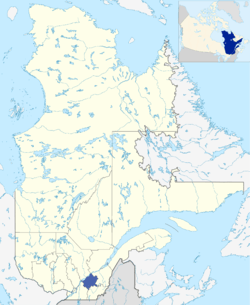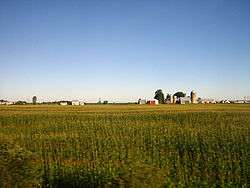Centre-du-Québec
Centre-du-Québec (French pronunciation: [sɑ̃tʁ dy kebɛk], Central Quebec) is a region of Quebec, Canada. The main centres are Drummondville, Victoriaville, and Bécancour. It has a land area of 6,930.05 square kilometres (2,675.71 sq mi) and a 2016 Census population of 242,399 inhabitants.[1]
Centre-du-Québec | |
|---|---|
Region | |
 Map of Centre-du-Québec in relation to Quebec. | |
| Coordinates: 46°17′N 72°04′W | |
| Country | |
| Province | |
| Government | |
| • Regional conference of elected officers | Lionel Fréchette (President) |
| Area | |
| • Land | 6,930.05 km2 (2,675.71 sq mi) |
| Population (2016)[1] | |
| • Total | 242,399 |
| • Density | 35.0/km2 (91/sq mi) |
| Website | www.centreduquebec.gouv.qc.ca |
Description

The Centre-du-Québec region was established as an independent administrative region of Quebec on July 30, 1997 (in effect August 20 upon publication in the Gazette officielle du Québec); prior to this date, it formed the southern portion of the Mauricie–Bois-Francs region (the northern part of which is now known simply as Mauricie).[2]
Centre-du-Québec is not located in the geographic centre of Quebec, though it is approximately located in the centre of the southern portion of the province. Some consider the name Bois-Francs to be synonymous with the Centre-du-Québec region; others see it as being synonymous with Arthabaska Regional County Municipality, with its main city Victoriaville earning the title Capitale des Bois-Francs (capital of the Bois-Francs).
The Centre-du-Québec is a primarily agricultural region known as the breadbasket of Quebec; major products include livestock and poultry, dairy products, as well as food crops such as cereals, vegetables, and fruits such as apples and cranberries. Forestry is also a major industry; the name "Bois-Francs" refers to the French term for hardwood, referring to the high density of hardwood forests in the area. Other major industries of the area include transportation, recycling, woodworking and cabinetmaking.
The Centre-du-Québec region derives great benefit from its central location; major centres such as Montreal and Quebec City are within an hour and a half's drive, while secondary centres such as Sherbrooke and Trois-Rivières are close at hand.
Subdivision
Regional County Municipalities
| Regional County Municipality (RCM) | Population Canada 2016 Census[3] |
Land Area | Density (pop. per km2) |
Seat of RCM |
|---|---|---|---|---|
| Arthabaska | 72,014 | 1,890.18 km2 (729.80 sq mi) | 38.1 | Victoriaville |
| Bécancour | 20,404 | 1,144.67 km2 (441.96 sq mi) | 17.85 | Bécancour |
| Drummond | 103,397 | 1,600.26 km2 (617.86 sq mi) | 64.6 | Drummondville |
| L'Érable | 23,366 | 1,286.81 km2 (496.84 sq mi) | 18.2 | Plessisville |
| Nicolet-Yamaska | 23,159 | 1,007.09 km2 (388.84 sq mi) | 23.0 | Nicolet |
Native Reserves
The Centre-du-Québec region is home to several thousand members of the Wabanaki Nation. They are scattered throughout the region, with two major population centres:
- Odanak, Quebec
- Wôlinak, Quebec
Major communities
- Bécancour
- Drummondville
- Kingsey Falls
- Nicolet
- Plessisville
- Princeville
- Saint-Cyrille-de-Wendover
- Saint-Germain-de-Grantham
- Victoriaville
- Warwick
Highways
Main highways in the region include:
See also
- List of regions of Quebec
- Quebec municipal elections, 2005, results in Centre-du-Québec
References
- "Census Profile, 2016 Census Centre-du-Québec [Economic region], Quebec". Statistics Canada. Retrieved November 22, 2019.
- "Modifications aux municipalités du Québec" (PDF). Bureau de la statistique du Québec. August 1997. ISSN 0843-8250. Retrieved 2012-05-20.
- "Population and Dwelling Count Highlight Tables, 2016 Census". Statistics Canada. Retrieved November 26, 2019.
External links
| Wikimedia Commons has media related to Centre-du-Québec. |
- (in French) Centre-du-Québec official website
- (in French) Centre-du-Québec government portal
- Centre-du-Québec tourist site
- (in French) Toile Jeunesse, a regional youth-oriented portal
- "Map of the Centre-du-Québec region" (PDF). Archived from the original (PDF) on 2007-08-09. (2.12 MiB)
- (in French) CRÉ|